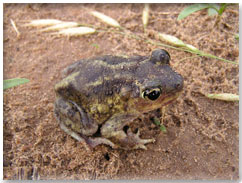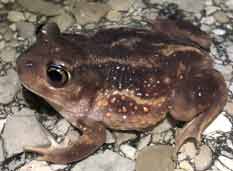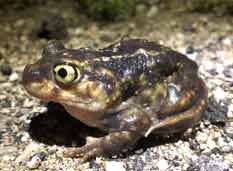 Description
Description
1 ¾-3 ¼” (4.4-8.3cm). Large protuberant eyes with vertical pupils. Stout, plump body that is brown or yellowish brown. Two yellow to cream stripes run from eye down back, forming a rough hourglass shape. Belly gray to white, without spots. Each hind foot has a pronounced “spade” tubercle used for digging.
Call Description
Single, loud, brassy note sounding like “Whar”. Very loud, especially in large choruses.
Indiana Range
Southern half of state. Occurs in sand deposits along Wabash, Ohio, and White River systems, and also in the karst and escarpment regions southern Indiana.
Diet
Eats invertebrates such as beetles, crickets, caterpillars, spiders and snails.
Habitat
Areas of loose or sandy soil including cultivated fields and forested areas.
Breeding Habitat
Shallow, temporary pools sometimes located in flooded lawns, agricultural fields, or other open areas.
Breeding Season
March to September, initiated by heavy rainfall.
 Eggs
Eggs
Deposited in bands or clusters up to a foot long. Can hatch in as little as 24 hours in hot weather, otherwise may take 2-3 days.
Tadpoles
Dark brown to bronze with fine orange dots. Tail has orange stripe, fins are transparent with dark rims. Metamorphoses in 2-9 weeks.

